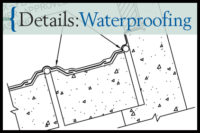Wood products represent a high percentage of all construction waste, as much as two thirds by some estimates, cast-in-place concrete formwork accounting for the majority of this. In-situ fabricated concrete formwork is also a very labor intensive activity. Preparation and removal of formwork can typically account for 40 percent of the total cost of cast-in-place concrete. Reduction in costs can be achieved by using reusable steel formwork and reusing wood formwork as many times as possible, but this works best with modular construction methods and is not suited for custom “one-off” projects. Another method to reduce waste and cost of formwork is to make the formwork a permanent, integral part of the cast-in-place assembly, widely in use today as insulating concrete forms.
The innovative use of fabric to form cast-in-place concrete is not a new one, but has been more of a novelty than anything else, limited mainly to art installations, furniture, and university experiments. But continued pressure to improve productivity and reduce costs without lowering the standard of quality has resulted in the emergence of new, viable methods for the widespread use of fabric formed concrete.
QUILT-POINT AND FRAME-RESTRAINT
An early innovator, Japanese architect Kenzo Unno, developed two methods of fabric formed cast-in-place concrete in response to the devastation of the 1995 Kobe earthquake. Unno wished to create safe concrete housing simple methods of construction with as little waste as possible. The first method, called quilt-point restraint, involves a geotextile fabric “bag” using standard concrete ties to hold the “bag” together, suspended and filled with ready mixed concrete from above. The ties and fabric forms are removed when the concrete has cured resulting in a soft, quilt-like appearance.
The “frame-restraint” method locates the geotextile fabric “bag” along the inside surface of a braced stud wall. The studs retrain the fabric against the pressure of the concrete as it is poured into the “bag” from the top. The final appearance of the wall is vertical in its expression, the fabric pushed out like half-round columns between the retraining vertical framing.
In both methods, “vibrating” of the concrete into the forms is done by poking at the fabric formwork as it billows out, for a high degree of control over the consolidation of concrete into the form. This results in a near perfect architectural concrete surface with very few rock pockets or bug holes.
ZERO-WASTE FABRIC FORMED CONCRETE
Unno’s ultimate vision of fabric formed concrete is his “Zero-Waste” wall in which “virtually no labor or material is wasted or discarded.” The Zero-Waste wall uses a reusable geotextile fabric that encloses rigid insulation on one side and either the “quilt-point” or “frame-restraint” method on the other. Reinforcement and ties are incorporated as necessary.
MAINSTREAM ADOPTION OF FABRIC FORMED CONCRETE
As interesting as Unno’s systems are, use has been limited to residential and light commercial buildings in Japan. In North America, fabric formed concrete pioneer Rick Fearn started Fab-Form Industries in Surrey, British Columbia, a company that develops and sells fully engineered fabric formed CIP footing and column systems. The company has developed unique fabric formed footing systems for residential, commercial and ICFs. The geotextile fabric used becomes a permanent part of the footing system which serves double duty as a moisture barrier that prevents the concrete from coming into contact with groundwater, keeping moisture out of the building. This is an important built-in feature of the system that offers a very elegant solution to the problem of how to prevent moisture from entering the building through concrete in contact with the ground.
Fab-Form footing systems can be installed over any type of terrain, flat and undulating. The fabric forms come in rolls and weigh considerably less than traditional plywood and steel formwork. A 12.5-pound roll of Fab-Form footing fabric can form the equivalent of 900 pounds of wood formwork, according to the company’s web site. That represents a huge reduction in greenhouse gas emissions due to transport of the formwork.
Fab-Form systems are very simple to prepare. Footing fabric is suspended between wood batter boards that are held in place at the desired height. After placement of steel reinforcement, concrete is poured into the suspended fabric, causing the fabric to take its pre-determined shape as the concrete pushes against the fabric. Complicated corners and other odd intersections and terminations can be custom designed and fabricated for each project based on specific needs, but most are simply job formed.
Fabric-formed columns are even easier with Fab-Form’s Fast-Tube system. The fabric tubes are manufactured in diameters from 8 to 20 inches, ship flat, and weigh 90 percent less than cardboard tube formwork. The fabric forms are held in position by stapling to a temporary vertical support and then filled with concrete. Once the concrete has cured for a sufficient amount of time, they are easily stripped and can be recycled for use as an under slab vapor retarder!
CONCLUSION
Fabric formed concrete shows promise in changing the way cast-in-place concrete is used for buildings. Mark West, Professor of Architecture at the University of Manitoba in the article “History and Overview of Fabric Formwork: Using Fabrics For Concrete Casting” states:
“… potential savings of both formwork materials and reinforced concrete, in turn leading to reductions in transportation, storage and labor as well as dead weight, which can have cascading savings throughout a concrete structure. This in turn can lead to savings in embodied energy and greenhouse gas emissions, making for more sustainable designs.”
With continued experimentation and development and increased popularity of available fabric formed systems, we may be seeing more of this interesting, intriguing way of forming cast-in-place concrete.







